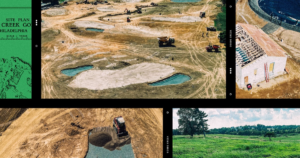Protecting just 1.2% of the Earth’s surface for nature would be enough to prevent the extinction of the world’s most endangered species, according to a new study.
Analysis published in the journal Frontiers in Science found that the targeted expansion of protected areas on land would be enough to prevent the loss of thousands of the mammals, birds, amphibians and plants closest to extinction.
From Argentina to Papua New Guinea, the team of researchers identified 16,825 sites that should be prioritized for conservation in the next five years to prevent the imminent extinction of animals and plants found nowhere else.
Dr Eric Dinerstein, of the environmental organization Resolve and lead author of the study, said the team was trying to identify the world’s rarest species with limited habitats, using the example of the peyote cactus, whose remaining range could be limited to small parts of the Chihuahuan Desert in North America.
“Most species on Earth are rare, meaning that species either have very narrow ranges or they occur at very low densities or both,” he said.
This study is focused on how imminent extinctions can be prevented, not on everything that would be needed to restore nature on Earth. Scientists say that more than the expansion of protected areas is needed to prevent the destruction of biodiversity and maintain ecosystems essential to human societies. In 2020 the researchers identified half of the Earth’s land surface that, if protected, will reverse biodiversity loss and enhance natural carbon removal.
Of the sites identified, which the authors called “conservation requirements,” 38% are within one and a half miles (2.5 km) of an existing protected area, indicating they could be potential quick wins. The PhilippinesBrazil, Indonesia, Madagascar and Colombia together were home to more than half of the sites.
In 2022, governments pledged to protect 30% of the planet for nature as part of the UN’s biodiversity targets, among more than 20 that aim to stem the great loss of nature around the world by the end of this decade. According to the UN, 16.6% of the world’s land surface and inland waters are protectedand many governments are deciding where to expand conservation areas.
However, the study found that governments often fail to protect the biodiverse areas that most urgently need protection. The authors estimated that between 2018 and 2023, only 7% of sites in new protected areas were home to the most threatened species.
Dinerstein said: “Despite the recent talk of extinction, the biodiversity crisis and what we need to do, only 7% of the new protected areas between 2018 and 2023 overlapped with the areas essential for conservation.
“It’s almost as if countries use a reverse selection algorithm and choose the non-rare sites to add to the global areas under protection. The call to arms of this paper is that we need to do a much better job in the next five years and it’s doable.”
Protecting the key sites they identify will cost $29bn-$46bn (£23bn-£36bn) over the next five years, covering 1.6m sq km (630,000 sq mi), the researchers said. This can be done through a combination of land purchases, the extension of indigenous rights and land titles, and the creation of protected areas on government-owned land.
The study compared global data on mammals, birds, reptiles, amphibians and plants to existing protected areas, using satellite analysis to identify remaining habitat for threatened species. Most of the areas identified for urgent protection were in the tropics, but grasslands, temperate broadleaf forests and tundra were also identified.
Prof Neil Burgess, who is Chief Scientist at the UN Environment Programme’s World Conservation Monitoring Centre, which is responsible for monitoring global progress on the expansion of protected areas, said the research was a useful suggestion for immediate action against extinction.
The paper, Burgess said, is an important reminder “that achieving 30% coverage by protected and conserved areas is not enough on its own, and that it is the location, quality and effectiveness of these protected and conserved areas that will determine whether they fulfill their role in contributing to halting biodiversity loss.”
Find more age of extinction coverage hereand follow biodiversity reporters Phoebe Weston and Patrick Greenfield on X for all the latest news and features






